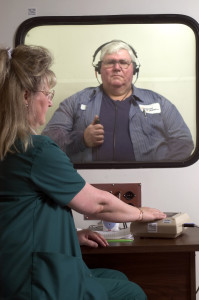We may take our ability to hear for granted – until we lose it. According
to The National Institute for Occupations Safety and Health (NIOSH), occupational
hearing loss is one of the most common work-related illnesses in the United
States. Approximately 22 million U.S. workers are exposed to hazardous
noise levels at work. Thousands of those workers actually suffer from
hearing loss due to high noise level exposure in their work environment.
When sound waves enter the ear, they cause the eardrum to vibrate. These
vibrations move to the inner ear, where tiny hair cells help produce nerve
impulses. The nerve impulses are then carried to the brain and interpreted
as sound. Exposure to loud noises, however, can damage the hair cells.
“Damage to hearing can happen all at once, like when a sudden loud
noise ruptures an eardrum,” said Jane Huitt, RN BSN COCH Director
of Occupational Health at CVMC, “It can also happen gradually over
time. For example continuous exposure to loud noises at work may lead
to progressive or sudden changes in the way we hear.”
Is noise a problem in your workplace?

The Occupational Safety and Health Administration (OSHA) provide these
signs of noise in the workplace.
Ask about audiograms/ hearing testing available at CVMC Occupational Health.
- You hear ringing or humming in your ears when you leave work.
- You have to shout to be heard by a coworker an arm’s length away.
- You experience temporary hearing loss when leaving work.
Here’s how you can prevent noise-induced hearing loss:
1. Know which noises can cause damage.
NIOSH recommends that all worker exposures to noise should be controlled
below a level equivalent to 85 decibels for eight hours to minimize occupational
noise induced hearing loss. To put this in perspective, here are some
specific sounds and their corresponding decibel levels:
2. Talk to your employer about ways to modify or replace the noise source
or along the transmission path to reduce the noise level at the worker’s
ear. Visit OSHA to find some examples of inexpensive, yet effective ideas.
3. If you can’t reduce the noise or protect yourself from it. Wear
earplugs or other protective devices when involved in a loud activity.
You should also have your hearing checked regularly. If you work in a noisy
place, like a factory, have your hearing tested at least once a year.
If hearing problems are suspected, an otolaryngologist is the type of
doctor who specializes in hearing. An audiologist is also trained to measure
hearing loss and provide help in coping with the problem.
CVMC Occupational Health offers a wide array of services for local businesses
including hearing screenings and audiograms. For more information, please
call 828.326-3230.